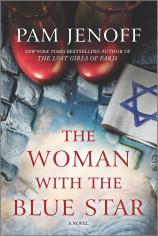The Woman with the Blue Star
Review
The Woman with the Blue Star
Pam Jenoff is known for her meticulously researched historical fiction, and THE WOMAN WITH THE BLUE STAR is no exception.
In at least one town in Poland, Jews descended into the sewers to live in hiding when the Nazis began emptying the ghettos and implementing their "final solution." As difficult as living in a sewer must have been --- and Jenoff describes it in such detail that we can see, feel and smell it --- that horrible existence was still better than the alternative.
The novel begins with a mystery in the present day. A gray-haired woman has traveled to Poland to meet someone. We see her watching an even older lady from her hotel window as the object of her fascination crosses a nearby street to sit in a café. The visitor finally works up the courage to meet her "target" face to face but thinks to herself, The woman I see before me is not the one I expected at all.
"Jenoff's writing and her depiction of day-to-day life during the Nazi occupation is engrossing. We feel connected to both girls, and the first-person narratives foster a feeling of empathy."
The story then moves back in time to March 1942, at which point we are introduced to two young women, both of whom are alike in some ways but quite different in others. Sadie Gault is a Jew who had lived with her parents in a comfortable apartment until they were forced to move to the Jewish ghetto. Ella Stepanek’s father died and left no will, so her stepmother, a German collaborator who treats her cruelly, inherits the estate. While Sadie's future is uncertain, she has her family to comfort her. Ella, on the other hand, has no one. Her brother lives in Paris with his boyfriend, though he wants her to live with them.
When the Nazis come to liquidate the ghetto, Sadie's father knows what to do. They escape in a hole under the apartment building's toilet into the sewer. Her mother is pregnant, and they can't bring much with them. Tragedy strikes almost immediately when her dad is killed saving her while they are crossing the river of sewage. Pawel, the Polish worker who helped devise this plan, shows Sadie, her mother and another family where they will be living until they can leave the sewer safely. One day, Sadie ventures under a grate and has a chance encounter with Ella. They form an unlikely --- and dangerous ---- friendship.
Jenoff's writing and her depiction of day-to-day life during the Nazi occupation is engrossing. We feel connected to both girls, and the first-person narratives foster a feeling of empathy. We worry when they take risks to be together and it becomes necessary for Ella to try to provide food for the sewer residents. Young and naive when the war started, they mature and make decisions that could cost them their lives, learning about what is truly important in life. It's not where you live, or the number of dresses in your closet, but rather the quality of those you live with and the friends you make.
There is a twist at the end that isn't really a surprise. While all the chapters begin with either Sadie's or Ella's name, one of the last chapters does not. It's a clue that we aren't supposed to know who the first-person narrator is until the Epilogue, where it all becomes clear.
I appreciate Jenoff's honesty when she explains that she scrapped 90% of her first draft and basically rewrote the story. I plan on sharing that with my students to show them that first drafts are not important; it's the final version that counts. And this final version is wonderful, thanks to her perseverance, diligence and outstanding talent.
Reviewed by Pamela Kramer on May 21, 2021
The Woman with the Blue Star
- Publication Date: May 4, 2021
- Genres: Fiction, Historical Fiction
- Paperback: 336 pages
- Publisher: Park Row
- ISBN-10: 0778389383
- ISBN-13: 9780778389385




